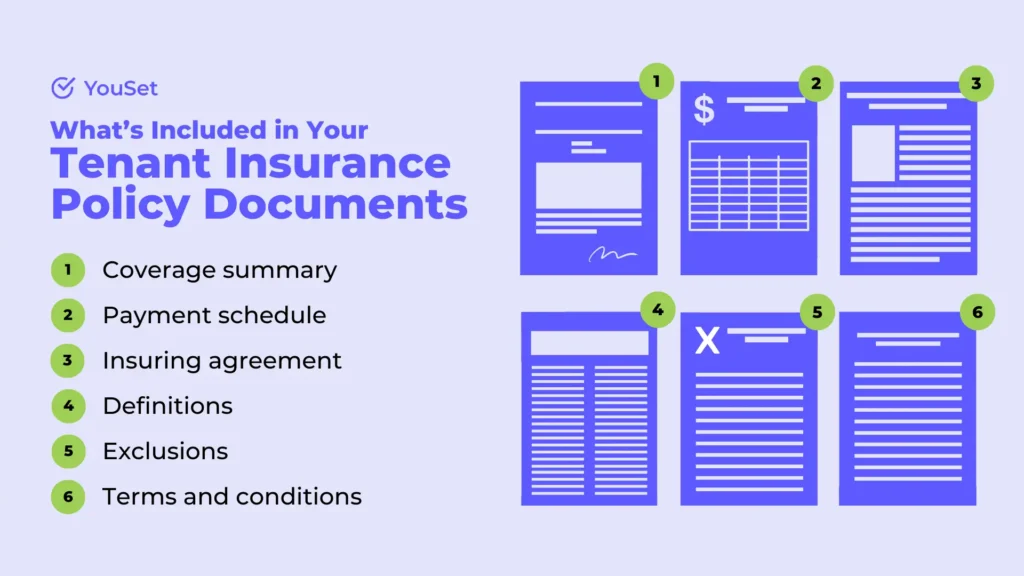In the days, sometimes hours, after you buy a tenant insurance policy, you can expect to receive a lengthy document from your insurer. When it arrives, what you don’t want to do is toss it in a corner or drawer, only for it to be forgotten. This is how you end up discovering too late that your personal information is incorrect or your coverage limits are inadequate for your situation.
Instead, you’re going to want to read it. No matter how boring or tedious it may seem right now, doing so could mean the difference between smoothly navigating future claims and encountering unexpected challenges or even denials.
In this article, we’ll guide you through how to read your insurance policy, so you can better understand the information that may impact your coverage and claims experience in the future. We’ll break down the six common sections typically found in a tenant insurance policy in Canada. Remember, however, that the organization and naming of these sections can vary widely between insurers.

Coverage summary
The coverage summary, which you might also find referred to as the declaration sheet, is typically one of the first pages included in your insurance policy documents. As the name suggests, it offers a high-level summary of who is insured, what is covered, and the associated cost. Its purpose is to give you quick access to the information you might need at a moment’s notice, saving you the hassle of sifting through the entire document.
In a tenant insurance policy, the coverage summary page will usually include:
- Your name
- Your address
- Your policy number
- Your policy term (start and end dates)
- Name of your insurance company
- Your insurance company’s contact details
- Your total premium
- Your coverages and their limits
- Your deductible
- Your discounts
- Your endorsements
Payment schedule
Besides the coverage summary page, the payment schedule is one of the most frequently visited sections of a tenant insurance policy – and for good reason! It outlines what you have to pay, how much you have to pay, and the various payment methods available to maintain continuous coverage. Your payment schedule will also often include the following:
- Annual premium amount
- Payment frequency
- Payment amount (Base amount, taxes, fees, total)
- Payment due dates
- Your chosen payment method or additional payment methods
- Fees or penalties for late payments
It’s crucial to verify the accuracy of the information provided in the payment schedule upon receiving your policy documents and then use that information to budget and manage your finances accordingly. Doing so will help prevent missed payments, costly late fees, and, worst of all, lapses in coverage that leave you uninsured and vulnerable to unexpected expenses.
Insuring agreement
At this point, tenant insurance policies usually start getting denser and more technical, which is naturally, when many people stop reading. However, the insuring agreement section and the sections that follow contain important information that you should make an effort to understand, at least to some extent.
After all, the insuring agreement section outlines what your insurer is contractually obligated to do for you, the policyholder. As such, this section typically includes the following types of information:
- List of the types of coverage included in the policy (ex. contents insurance, tenant liability coverage, additional living expenses coverage, etc.)
- List of the perils or events that the policy covers (ex. fire or theft)
- Insurer’s responsibilities in the event of a covered loss (ex. reimbursement for claims)
- Policyholder’s responsibilities (ex. reporting losses within the outlined timeframe)
Definitions
Somewhere in your policy documents, your insurer will provide a list of definitions for the terms and phrases used throughout the policy. This is intended to reduce confusion and misinterpretations. Often, as you read through your documents, you will notice certain words bolded. These bolded terms are likely defined in the definitions section of the policy.
Exclusions
The exclusions section of your tenant insurance policy details the types of damages, losses, and situations that are not covered. This information is particularly important because it reveals your areas of vulnerability and the risks you’ll need to manage on your own. Understanding this upfront allows you to take preventative measures and mitigate any potential risks as a renter.
Here are some common exclusions you can expect to find in this section:
- Intentional or criminal acts
- Gradual damage (wear and tear)
- Use of rental unit for business activities
- High-value items
- War and terrorism
- Negligence
Terms and conditions
The terms and conditions will typically be the last section of your tenant insurance policy. Essentially, it’s the set of rules that both you, the policyholder, and the insurer agree to follow. It will also include information about any actions that could impact the validity of your insurance protection, each other’s responsibilities during claims, and the procedures for canceling or renewing the policy.
Given that failing to meet these conditions could jeopardize the outcome of any claims you make and potentially result in a denial of coverage, it’s crucial to familiarise yourself with the terms and conditions of your policy as early as possible. Also, always keep the first copy you receive. If any changes are made during the term, you’ll only receive the modified sections, as the rest of the original policy remains valid.



